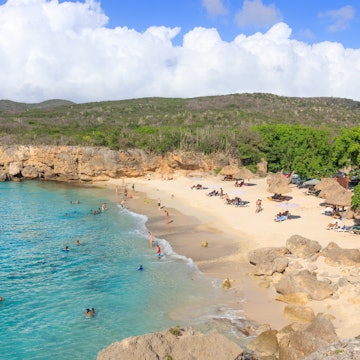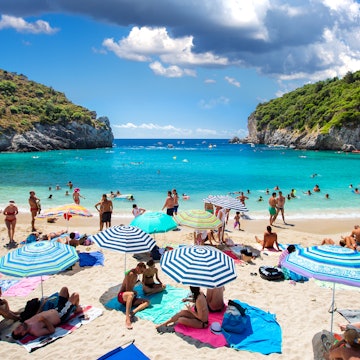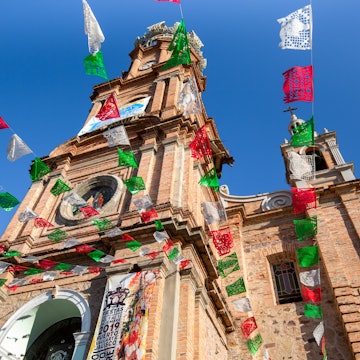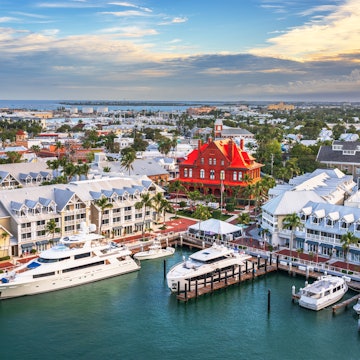
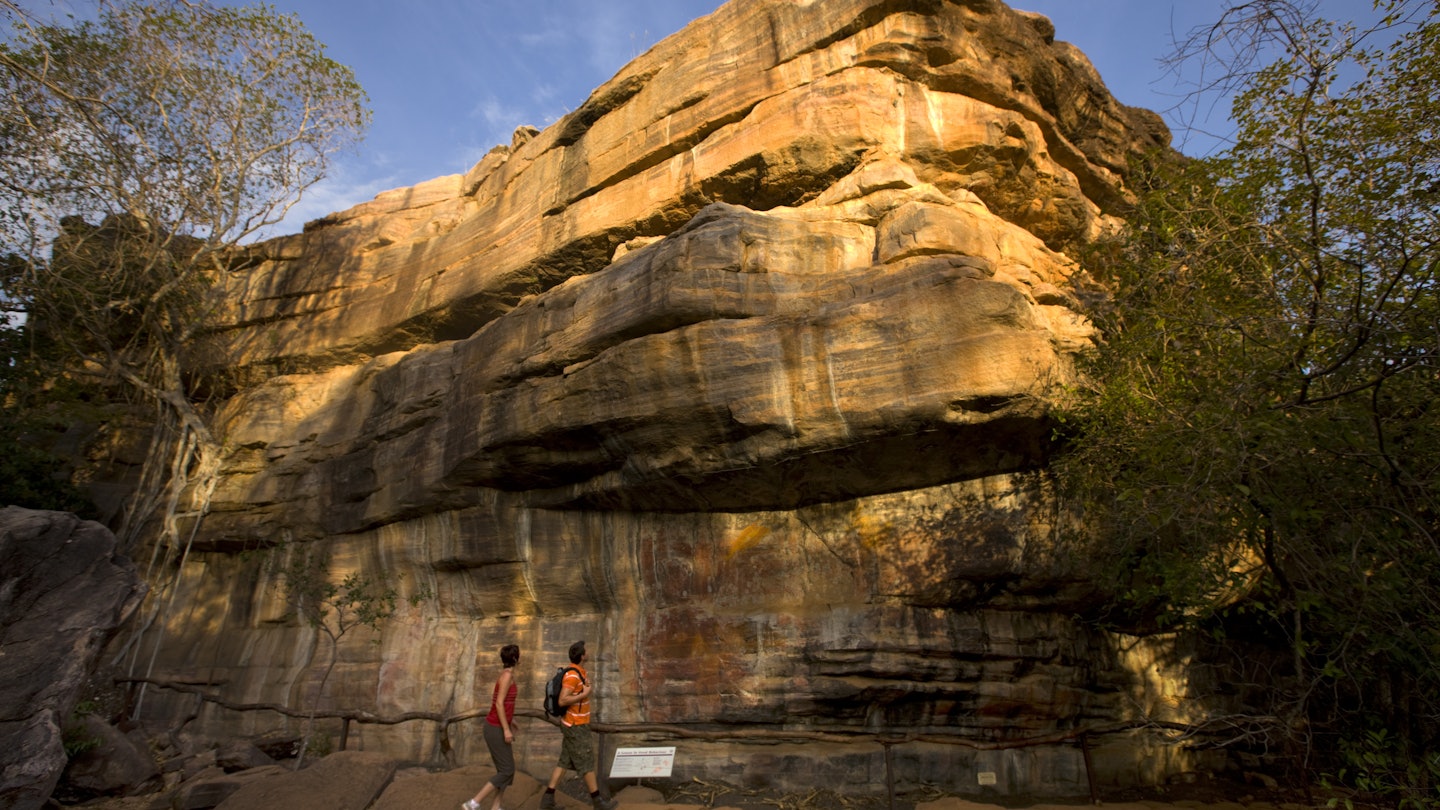
Aboriginal art tells a story that began on remote rock walls and now encompasses an astonishing diversity of regional styles that can be seen in-situ or in art galleries the world over. As you journey through the Northern Territory, visiting Aboriginal art centres will give you the opportunity to enjoy authentic, unscripted cultural encounters, and the chance to buy art you cannot get anywhere else directly from the creators themselves.

Art and Country
It is through rock art on remote escarpments, paintings produced by the ancestors of Australia's First Nations, that we learn about the human habitation of this land. In the absence of written records, these precious works tell a story of Country that is tens of thousands of years old. By Country, Aboriginal Australians mean more than just the landscape, it includes all living things: the people, plants and animals, embraced by the seasons, stories and creation spirits. For Aboriginal Australians, Country is a place of belonging and a way of believing.
The first Aboriginal artist to earn an international reputation was Albert Namatjira (1902 –1959), a Western Arrernte man from the MacDonnell Ranges outside Alice Springs. His first solo exhibition in Melbourne in 1938, where 41 paintings sold out in three days, put a critical spotlight on the artistic skill of Aboriginal Australians. At the time, Namatjira painted Central Australian landscapes with watercolours in a predominantly European style. It was not until the distinctive Aboriginal dot paintings, which impart information or share Aboriginal lore, were translated from the land to canvases in the 1970s that Aboriginal Australian art became a global phenonemon.

Engaging with Aboriginal Australian artist practices opens up new perspectives, providing a prism through which the uninitiated can catch glimpses of Country through the eyes of its custodians. Many travellers have looked at a dot painting from the Western Desert, from Papunya or Kintore or Yuendumu, and in a perspective-altering moment, imagined themselves looking down upon the spinifex-stamped plains and snaking dry riverbeds of the Gibson or Tanami Deserts.
Similarly, hold a bark painting from the Yolngu people and you may be transported to swampy paperbark forests of Arnhem Land or hear the echoes of millennia-old ochre painting daubed expertly on the rock walls of Kakadu and along the Arnhem Land Escarpment. There are numerous books and websites available to learn more about the styles, symbolism and story behind this vast body of works: Aboriginal Art, by Wally Caruana is an excellent resource to start.
While you are on Country
Darwin and Alice Springs have many art centres with strong roots in remote Aboriginal communities. The best ones are run according to principles that ensure the interests of the painters are paramount, principles that also serve as guides to ethical buying of Aboriginal art. As a starting point, artists should be receiving at least 50% of the proceeds of any sales. Further, all reputable centres should be able to provide detailed biographies of each artist, as well as the story behind each work.

Aboriginal art centres can also act as a gateway to Indigenous Australia for travellers who might not otherwise have many other opportunities to meet with locals, except in more organised and ceremonial tourism experiences.
Visiting an Aboriginal art centre
Hubs of daytime social interaction and focal points for the commercial life of entire small towns, art centres draw creative talents – wise old painters whose work is coveted by international collectors, young hopefuls with a raw, untamed style – who go there to paint, to talk, to pass the time. Most often the atmosphere is casual – one of quiet creativity.
There are usually two main aspects to these art centres. One is the shop or showroom, a gallery-like space with fixed prices. You'll get to see a range of artworks from less expensive works by beginner artists to expert pieces whose prices run into the thousands.

The second, more diffuse collection of artistic spaces occupies the rest of the centre’s building and grounds. These spaces can include a mix of indoor studios, informal outdoor painting spaces on a breezy verandah, or even out under a tree; the latter is often the preferred space for those artists, often women, who produce intricate basketwork from the products of the local pandanus palm.
Time to visit
Assuming you have checked the opening hours of the centre you wish to visit (most close on weekends), you can simply turn up. To avoid crowds – and enjoy your experience more – arrive soon after they open or late in the afternoon, but set aside at least a couple of hours.
To get a feel for the local artistic style and appreciate the range of what’s on offer, begin in the showroom. Aboriginal artists work with different media: painting, sculpture, engraving, weaving, printmaking, photography, and textile design so don't limit your browsing. See what work resonates with you (and what is within your budget). It's also important to establish how the gallery operates in terms of profit-sharing with the artists they represent, so feel free to ask.
Allow time to observe and work your way through what may be an initial sensory assault of closely hung artworks. It’s always worth asking which of the artists are in residence on the day of your visit – if you’re fortunate, you may be able to watch a master at work.

It’s time now to venture out into the creative spaces to observe the artists at work. Most Aboriginal artists are welcoming – but often shy. The sudden arrival of bus-loads of tourists can be confronting, as it would be for any artist, but some spend much of their lives on remote outstations far from the clamour of Australia’s cities. Slow down. Patience and presence is key.
Greet the artists when you arrive, then when you feel comfortable pull up a chair or sit quietly, and watch these painters and expert craftspeople at work. It's a rare privilege to sit and watch an artist working, savour the opportunity.
Some artists will willingly discuss their work, their techniques, where they’re from, but first you’ll need to become a part of the furniture, to sit in unconfrontational silence and with a patient, generous spirit until conversation, possibly halting at first, develops.
At the end of your visit, you may leave with an original piece to treasure back home.... stay long enough and you might leave with warm memories of an encounter where you gained precious insight into the world of Australia's indigenous culture.
Aboriginal art centres in the Northern Territory
Coomalie Cultural Centre, Batchelor (cac.batchelor.edu.au) In Batchelor on the cusp of Litchfield National Park.
Merrepen Arts, Daly River (merrepenarts.com.au) One of the more innovative art centres.
Injalak Arts & Crafts Centre, Gunbalanya / Oenpelli (injalak.com) One of the Northern Territory’s most impressive art centres.
Ghunmarn Culture Centre, Beswick / Wugularr (djilpinarts.org.au) Also known as Djilpin Arts.
Ngukurr Arts Centre, Ngukurr (ngukurrarts.net) On the road through southwestern Arnhem Land.
Waralungku Arts Centre, Borroloola (waralungku.com). Out on the Gulf of Carpentaria. Ask about their excellent art-and-culture immersion experiences.
Warlukurlangu Art Centre, Yuendumu (warlu.com) On the Tanami Track in Yuendumu.






